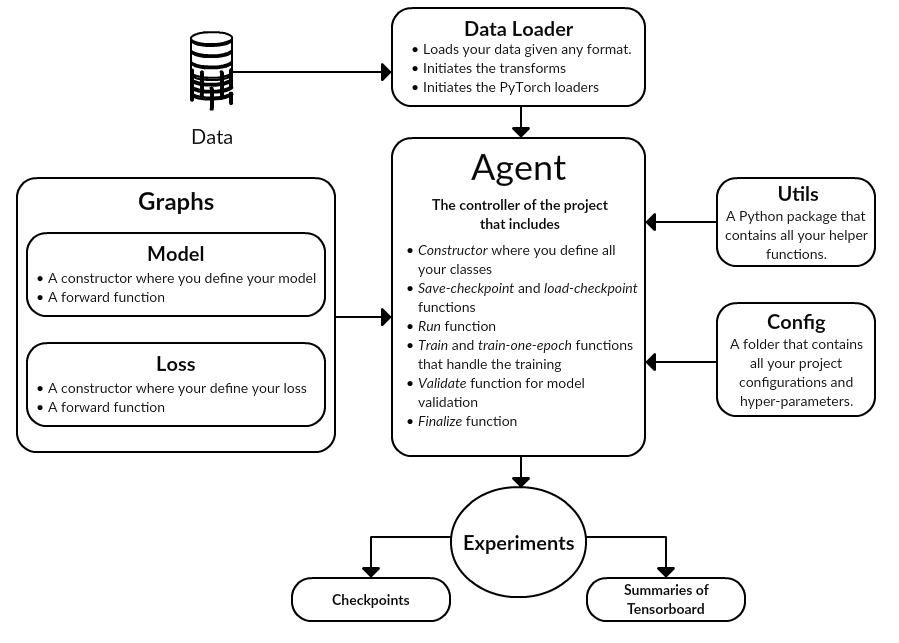Implement your PyTorch projects the smart way.
A Scalable template for PyTorch projects, with examples in Image Segmentation, Object classification, GANs and Reinforcement Learning.
Given the nature of deep learning projects, we do not get the chance to think much about the project structure or the code modularity. After working with different deep learning projects and facing problems with files organization and code repetition, we came up with a modular project structure to accommodate any PyTorch project. We also wanted to provide a base for different PyTorch models for the community to build upon.
This is a joint work between Hager Rady and Mo'men AbdelRazek
We are proposing a baseline for any PyTorch project to give you a quick start, where you will get the time to focus on your model's implementation and we will handle the rest. The novelty of this approach lies in:
- Providing a scalable project structure, with a template file for each.
- Introducing the usage of a config file that handle all the hyper-parameters related to a certain problem.
- Embedding examples from various problems inside the template, where you can run any of them independently with a single change in the config file name.
- Tutorials to get you started.
We are providing a series of tutorials to get your started
- Getting Started Tutorial: where we provide a guide on the main steps to get started on your project.
- Mnist Tutorial: Here we take an already implemented NN model on Mnist and adapt it to our template structure.
- We want this template to be a central place for many variations of the well-known PyTorch Deep learning models.
- We are welcoming any contribution from the community that will make this come true so we urge people to add their PyTorch models into the template.
- We are also welcoming any proposed changes or discussions about the class design pattern used in this project.
- ERFNet: A model for Semantic Segmentation, trained on Pascal Voc
- DCGAN: Deep Convolutional Generative Adverserial Networks, run on CelebA dataset.
- CondenseNet: A model for Image Classification, trained on Cifar10 dataset
- DQN: Deep Q Network model, a Reinforcement Learning example, tested on CartPole-V0
- We started by DCGAN, adding its custom configs into the json file. DCGAN has both generator and discriminator model so it doesn't have a single model file.
- Then, we added CondenseNet, where it was necessary to create a custom blocks folder inside the models folder to include the definitions for custom layers within the model.
- After that, we added the DQN project, where all the classes related to the environment have been added to the utils. We also added the action selection and model optimization into the training agent.
- ERFNet was the last example to join the template; agent, model and utils have been added to their folders with no conflicts.
This is to ensure that our proposed project structure is compatible with different problems and can handle all the variations related to any of them.
After adding all our examples, the repo has the following structure:
├── agents
| └── dcgan.py
| └── condensenet.py
| └── mnist.py
| └── dqn.py
| └── example.py
| └── base.py
| └── erfnet.py
|
├── configs
| └── dcgan_exp_0.py
| └── condensenet_exp_0.py
| └── mnist_exp_0.py
| └── dqn_exp_0.py
| └── example_exp_0.py
| └── erfnet_exp_0.py
|
├── data
|
├── datasets
| └── cifar10.py
| └── celebA.py
| └── mnist.py
| └── example.py
| └── voc2012.py
|
├── experiments
|
├── graphs
| └── models
| | └── custome_layers
| | | └── denseblock.py
| | | └── layers.py
| | |
| | └── dcgan_discriminator.py
| | └── dcgan_generator.py
| | └── erfnet.py
| | └── erfnet_imagenet.py
| | └── condensenet.py
| | └── mnist.py
| | └── dqn.py
| | └── example.py
| |
| └── losses
| | └── loss.py
|
├── pretrained_weights
|
├── tutorials
|
├── utils
| └── assets
|
├── main.py
└── run.sh
easydict==1.7
graphviz==0.8.4
gym==0.10.5
imageio==2.3.0
matplotlib==2.2.2
numpy==1.14.5
Pillow==5.2.0
scikit-image==0.14.0
scikit-learn==0.19.1
scipy==1.1.0
tensorboardX==1.2
torch==0.4.0
torchvision==0.2.1
tqdm==4.23.4
We are planning to add more examples into our template to include various categories of problems. Next we are going to include the following:
This project is licensed under MIT License - see the LICENSE file for details
